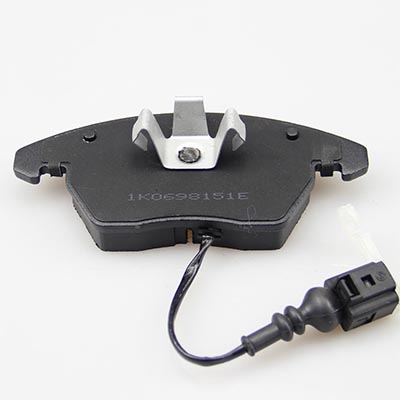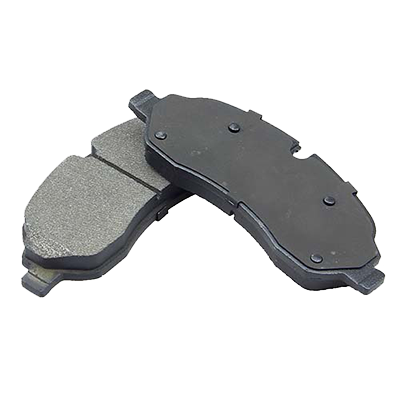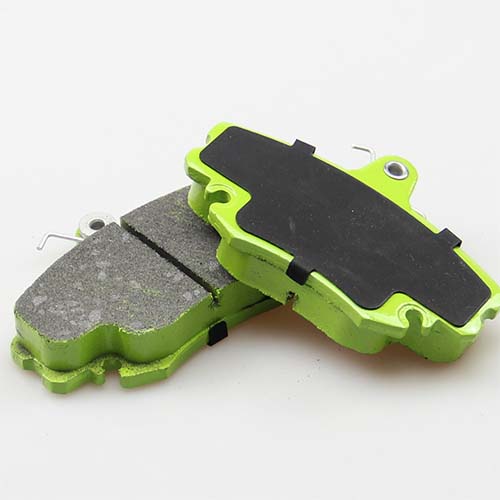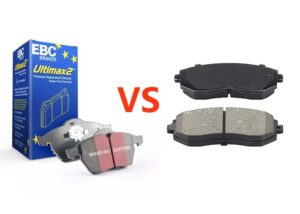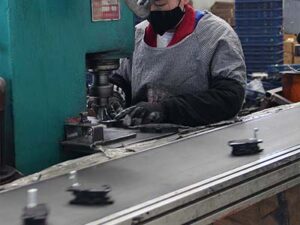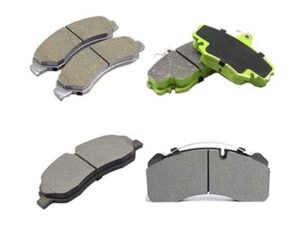In a car’s braking system, brake pads stand as the paramount safety component. They hold the decisive role in determining the effectiveness of braking, making quality brake pads the guardians of both driver and vehicle safety.
Composed typically of a steel backing plate, adhesive insulation layer, and friction block, brake pads are designed for optimal performance. The insulation layer, crafted from non-heat-conductive material, serves the purpose of heat insulation. Meanwhile, the friction block, comprised of friction material and adhesive, undergoes compression during braking, generating friction against the brake disc or drum, thereby facilitating vehicle deceleration and braking.
Hence, the selection of appropriate and high-quality brake pads is of utmost importance. Drawing from 24 years of brake pad expertise, our criteria for choosing brake pads should encompass factors such as friction coefficient, heat resistance, vehicle model compatibility, and warranty coverage.
Based on these considerations, we can provide guiding principles for selecting brake pads:
Key Points
- The friction coefficient of brake pads fundamentally determines the braking force, thus directly affecting the braking performance. Therefore, the selection of the friction coefficient for brake pads is of utmost importance. A low friction coefficient results in poor braking performance, feeling soft, and excessively long braking distances. Conversely, a high friction coefficient may lead to issues such as wheel lock-up and loss of control, necessitating careful consideration during brake pad selection. KETULLA brake pads are divided into four grades, each with corresponding friction coefficients ranging from 0.38 to 0.55. Scientific brake pad grading facilitates easier selection for vehicle owners
- When brake pads are in operation, they not only generate powerful braking force but also accompany extremely high temperatures. The heat resistance of brake pads is directly related to the safety of the braking system. Low-quality brake pads may experience a decrease in friction coefficient and even brake failure under high-temperature conditions, posing a significant risk
- When replacing new brake pads or driving a new vehicle, there is a chance of experiencing brake juddering, unusual noises, and odors. There are two main reasons for these phenomena: firstly, inferior quality brake pads; secondly, poor suitability or compatibility of the brake pads. New brake pads may not properly bed in with the brake discs, or there may be gaps between the brake pads and the calipers, leading to such issues. Ketulla brake pads feature a brand-new design that offers a closer fit to the brake discs, with grooved patterns for improved heat dissipation. Additionally, Ketulla brake pads come equipped with noise reduction pads, effectively eliminating any noise and juddering.
- The durability of brake pads is closely related to the materials and manufacturing processes used. Brake pads with better durability have longer lifespans. Ketulla brake pads utilize new ceramic materials and ceramic adhesives, offering excellent durability and extended lifespan, thus enhancing safety.
The brake pads materials types
Normally, we call semi-metallic, low metallic, ceramic brake pads, It is classified based on friction materials.
Ceramic Brake Pads: Ceramic brake pads are made from ceramic fibers and non-ferrous filler materials. They offer excellent braking performance, low dust generation, and reduced noise levels compared to organic and semi-metallic brake pads. Ceramic brake pads are often favored for their longevity and consistent performance.
Semi-Metallic Brake Pads: Semi-metallic brake pads contain 30%~50% metal fibers, typically steel, along with other materials such as organic compounds and resins. These brake pads offer enhanced durability and heat dissipation, making them suitable for high-performance applications. However, they may produce more brake dust and noise compared to ceramic brake pads.
Low Metallic Brake Pads: Low metallic brake pads are constructed using metal fibers bonded with resin. They are renowned for their superior braking power and performance, particularly in high-stress driving conditions. However, metallic brake pads tend to be noisier and can cause accelerated wear on brake rotors.
Pros and Cons of Each Type
KETULLA has 3 types of brake pads, semi-metallic, low metallic, and ceramic formulations, here are the Pros and Cons of each type:
Semi-metallic
Pros:
- Durability and long lifespan, suitable for heavy-duty and high-performance applications.
- Good heat dissipation properties, especially during aggressive driving or towing.
- Cost: a cost-effective option for many drivers.
- Stable performance operating temperatures and driving conditions
Cons:
- Produce more noise and brake dust compared to ceramic brake pads
- Cause faster wear on brake rotors compared to ceramic brake pads
- Have a slightly different initial brake feel compared to other types of brake pads
- Reduced performance in cold weather conditions, such as decreased stopping power and increased brake noise until they reach operating temperature.
Low-metallic
Pros
- Strong and consistent stopping power, suitable for various driving conditions, including heavy brake pads for truck
- Good heat dissipation properties, and maintain braking performance even under high-temperature conditions.
- Durability and long lifespan, make them a reliable choice for vehicles
- Cost-Effectiveness: Compared to ceramic brake pads, semi-metallic brake pads are often more affordable
Cons:
- Brake Dust and Noise: More brake dust and noise compared to ceramic brake pads
- cause faster wear on brake rotors, potentially requiring more frequent rotor replacements.
- A slightly different initial brake feel may require an adjustment period for optimal performance.
- May exhibit reduced performance in cold weather conditions, such as decreased stopping power and increased brake noise until they warm up.
Ceramic
Pros:
- Offer strong and consistent stopping power, providing reliable performance in various driving conditions, including high-speed stops and heavy braking.
- Produce minimal brake dust and noise compared to other types of brake pads, resulting in a cleaner wheel appearance and a quieter driving experience.
- Have excellent heat dissipation properties, which help minimize brake fade and maintain consistent braking performance even under high-temperature conditions.
- Durability and long lifespan, make them a cost-effective option over the long term despite their initial higher cost.
Cons:
- Ceramic brake pads are typically more expensive than other types of brake pads, which may deter some drivers who are on a tight budget.
- Brake Rotor Wear: While ceramic brake pads are gentle on brake rotors, they may cause accelerated wear on the rotors compared to organic brake pads, potentially leading to more frequent rotor replacements.
- Cold Weather Performance: Ceramic brake pads may exhibit reduced performance in cold weather conditions until they warm up, which could result in slightly longer stopping distances and increased brake noise until the pads reach operating temperature.
- Compatibility Issues: Ceramic brake pads may not be compatible with all types of brake systems, so it’s essential to ensure they are suitable for your vehicle before installation.
The Feature of types of brak e pads
We all care about the cost of brake pads, as we seek high-performance pads at low prices. For KETULLA brake pads, whether ceramic, low metallic, or semi-metallic, our wholesale prices are exceptionally low, while still maintaining excellent braking performance. Below is a comparison of KETULLA brake pad prices. Prices vary depending on the model and material.
Project | Low metallic | Semi-Metallic | Ceramic |
Friction coefficient | 0.35~0.45 | 0.4~0.45 | 0.45~0.55 |
Compatible cars | Aggressive Driving: Trucks, passager cars, Light vehicles; Commercial cars | Truck Passgers cars, Light Vehicles, Commercial cars | Passager Cars, Light vehicles |
Dust | Low dust | Low dust | No dust |
Noise | Low noise | Low noise | No noise |
Cost | Low price | Medium Price | High price |
The causes of the squeak of brake pads
When we go to install our brake pads, we are certainly concerned about noise generation. There are many factors contributing to noise, so what we should do is: Use reliable brake pads
Such as bellows best brake pads, known for their low noise performance and high quality.
- Akebono ULTRA-PREMIUM BRAKE PADS: Best Replacement Brake Pad manufacturer
- Power Stop Z23 Evolution Sport Carbon Fiber-Infused Pads: Best High-Tech Brake Pads
- Advics ultra-premium-brake-pads: Best High-Performance Street Pads
- EBC Redstuff: Best Ceramic Low-Dust Brake Pads
- KETULLA Low metallic, semi-metallic, ceramic brake pads: best OEM brake pads manufacturer with running for 24 years.
At the same time, we should also seek out reputable repair shops for replacement because it’s essential to inspect crucial components such as brake discs before replacing brake pads. If there’s any damage, it needs to be replaced. This approach significantly reduces the likelihood of noise occurrence
Check the warranty of the brake pads
The warranty period of brake pads is also a crucial consideration not to be overlooked. Brake pad manufacturers typically provide recommendations, and for KETULLA, our warranty ranges from 30,000 to 50,000 kilometers. Of course, this duration depends on your driving habits and road conditions. Generally, brake pads should be replaced between 50,000 to 80,000 kilometers to ensure your driving safety.
Even if the thickness of our brake pads is still within acceptable limits upon inspection, the material composition and characteristics of brake pads can be affected by the length of your driving mileage.
Choose the right brake pads for your vehicles or your business
Whether you’re an individual or a commercial entity, the criteria for selecting brake pads must prioritize excellent braking performance, low noise, and minimal dust. Additionally, it’s essential to choose manufacturers with excellent expertise in brake pad production and problem-solving capabilities. KETULLA perfectly aligns with these criteria:
- Professional brake pads manufacturer and supplier with running for 24 years
- 35~45 days delivery time
- 30000~50000km warranty time.
- Holding certificates: Emark, Ameca, TS16949.
- Covering 2351 brake pad models.
- Brake pads (Low metallic, Semi-metallic, Ceramic) are compatible with Japanese cars, Korean Cars, Chinese cars, and Euro cars.
So, are you ready to experience the KETULLA difference? Look no further, contact us now for free samples for your test or machine test
